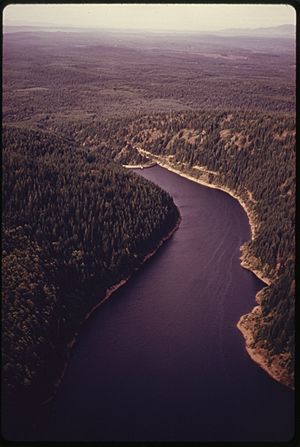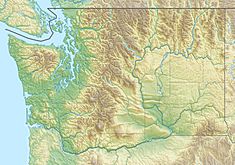Casad Dam facts for kids
Quick facts for kids Casad Dam |
|
|---|---|

Casad Dam (near center) and Union River reservoir
|
|
|
Location of Casad Dam in Washington
|
|
| Country | United States |
| Location | Bremerton, Washington |
| Coordinates | 47°32′17″N 122°46′47″W / 47.53806°N 122.77972°W |
| Purpose | Municipal water supply |
| Status | Operational |
| Construction began | 1955 |
| Opening date | 1957 |
| Construction cost | $1.4 million |
| Owner(s) | City of Bremerton |
| Dam and spillways | |
| Type of dam | Concrete arch |
| Impounds | Union River |
| Height | 190 ft (58 m) |
| Length | 416 ft (127 m) |
| Elevation at crest | 643.7 ft (196.2 m) |
| Width (base) | 56 ft (17 m) |
| Reservoir | |
| Creates | Union River Reservoir |
| Total capacity | 1,400,000,000 US gal (5,300,000 m3) |
| Catchment area | 3,000 acres (1,200 ha) |
| Surface area | 40 acres (16 ha) |
| Normal elevation | 607 ft (185 m) |
| Coordinates from USGS, specifications from factsheet unless noted | |
The Casad Dam is a large concrete dam located in Bremerton, Washington. It was built between 1955 and 1957. This dam is very important because it helps provide more than half of the drinking water for the city of Bremerton.
The dam creates a big lake called the Union River Reservoir. This reservoir collects water from the Union River. The water then travels from the reservoir, which is high up in the hills, down to the city. This happens naturally because of gravity, like water flowing downhill.
Casad Dam: Bremerton's Water Source
Casad Dam is the only major structure in Kitsap County that collects water for a city. It holds back the Union River to form the reservoir. This reservoir is a key part of Bremerton's municipal water supply, which means it provides water for homes and businesses.
The city of Bremerton owns most of the land around the reservoir. This land, called a watershed, covers about 3,000 acres. The Union River Reservoir can hold a huge amount of water: about 1.4 billion US gallons!
How Bremerton Gets Its Water
Bremerton gets most of its water from this open-air reservoir. This is a bit unusual for a city. Sometimes, tiny plants called algae can grow a lot in the water. When this happens, it can affect the water quality. However, the city works hard to keep the water clean and safe for everyone to drink.
Keeping the Dam Safe
Dams need to be very strong to hold back so much water. The Casad Dam's intake tower, which is where water enters the pipes, was made even stronger in 2012. This process is called a seismic retrofit. It means the tower was updated to better handle a strong earthquake.
This is important because the Seattle Fault, a major earthquake fault line, is only about four miles away. Making the dam stronger helps protect the city's water supply in case of a big earthquake.


